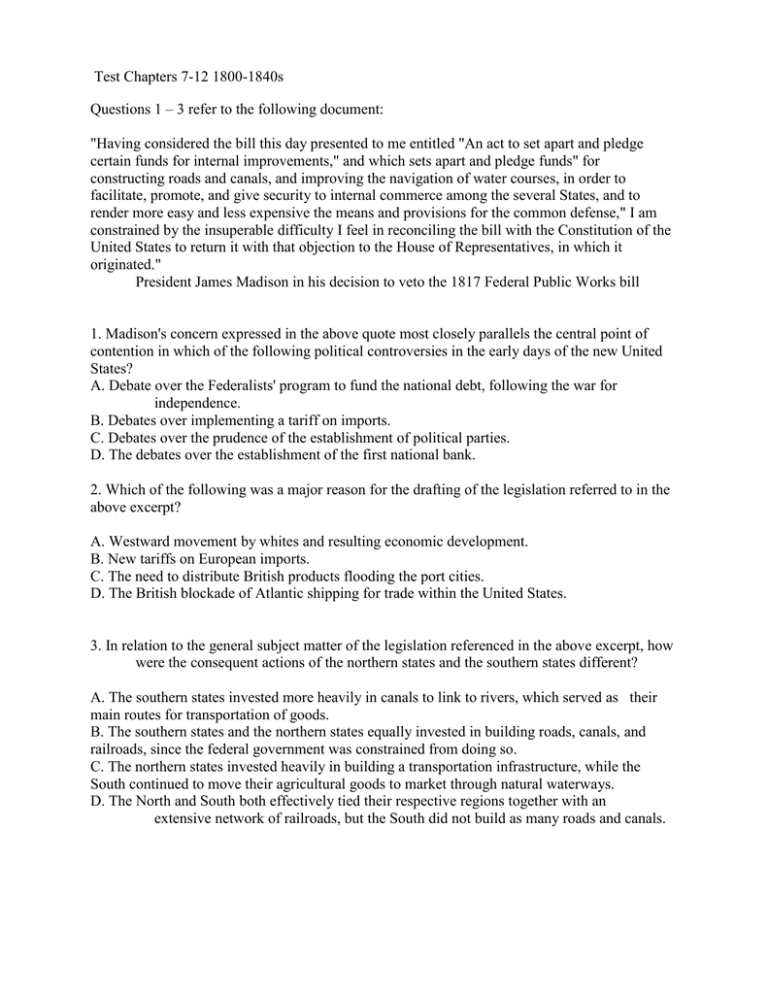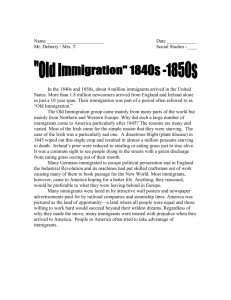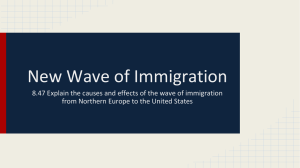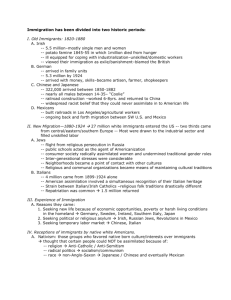Unit 4 test - OCPS TeacherPress
advertisement

Test Chapters 7-12 1800-1840s Questions 1 – 3 refer to the following document: "Having considered the bill this day presented to me entitled "An act to set apart and pledge certain funds for internal improvements," and which sets apart and pledge funds" for constructing roads and canals, and improving the navigation of water courses, in order to facilitate, promote, and give security to internal commerce among the several States, and to render more easy and less expensive the means and provisions for the common defense," I am constrained by the insuperable difficulty I feel in reconciling the bill with the Constitution of the United States to return it with that objection to the House of Representatives, in which it originated." President James Madison in his decision to veto the 1817 Federal Public Works bill 1. Madison's concern expressed in the above quote most closely parallels the central point of contention in which of the following political controversies in the early days of the new United States? A. Debate over the Federalists' program to fund the national debt, following the war for independence. B. Debates over implementing a tariff on imports. C. Debates over the prudence of the establishment of political parties. D. The debates over the establishment of the first national bank. 2. Which of the following was a major reason for the drafting of the legislation referred to in the above excerpt? A. Westward movement by whites and resulting economic development. B. New tariffs on European imports. C. The need to distribute British products flooding the port cities. D. The British blockade of Atlantic shipping for trade within the United States. 3. In relation to the general subject matter of the legislation referenced in the above excerpt, how were the consequent actions of the northern states and the southern states different? A. The southern states invested more heavily in canals to link to rivers, which served as their main routes for transportation of goods. B. The southern states and the northern states equally invested in building roads, canals, and railroads, since the federal government was constrained from doing so. C. The northern states invested heavily in building a transportation infrastructure, while the South continued to move their agricultural goods to market through natural waterways. D. The North and South both effectively tied their respective regions together with an extensive network of railroads, but the South did not build as many roads and canals. Questions 4-6 refer to the “A firm union will be of the utmost moment to the peace and liberty of the states, as a barrier against domestic faction and insurrection.” Alexander Hamilton “I am not a friend to a very energetic government. It is always oppressive. It places the governors indeed more at their ease, at the expense of the people.” Thomas Jefferson 4. Which of the following was the most direct result of the ideas expressed in the quotes above? a. The development of the first political party system in American politics b. Disagreements over religious denominations within the colonies c. Failure to solve problems relating to Native American land claims d. The creation of a national market economy 5. Which of the following was most supportive of the ideas expressed by Hamilton? a. Democratic-Republican support for the French in their conflicts with Great Britain b. The South’s insistence on remaining politically isolated from the North c. Supreme Court decisions in the early nineteenth century d. The growth of the internal slave trade following the ratification of the Constitution 6. Which of the following developments most strongly contradicted the ideas expressed in Jefferson’s statement? a. State resistance to federal tariff laws b. The federal government’s purchase of the Louisiana Territory c. The South’s dependence on agriculture d. The failure to re-charter the national bank Questions 7-8 7. The image above most directly reflected the view of Andrew Jackson by which following groups? A) Southern Farmers B) Native American Sympathizers C) Whigs and National Republicans D) Non-land owning White Males 8. Which of the following issues best reflected Jackson's abuses of executive power? A) Passage of the Force Bill to prevent South Carolina's secession B) the economic depression that Van Buren's presidency was forced to resolve C) his refusal to uphold certain Supreme Court rulings D) his frequent use of the veto power The banner reads: “William Henry Harrison, The Farmer of North Bend” Harpers Weekly Magazine, 1840 What was the purpose behind the publication of the 1840 illustration above? 9. A. To attack William Henry Harrison for being a poor, uneducated farmer B. To portray William Henry Harrison as a common man C. To create support for the populist movement D. To criticize the “log cabin” mentality and the manufacture hard cider 10. What future trend in Presidential elections was started in 1840? A. Campaigns where candidates engaged in character defamation against their opponents as part of their strategy. B. The use of the eagle as a patriotic symbol on candidate campaign materials C. Presidential elections with candidates from three political parties D. Using local newspapers to circulate campaign materials such as slogans, images and candidate statements. 11. The painting above illustrates Andrew Jackson’s Native American policy that was expressed in the a. Indian Removal Act b. Monroe Doctrine c. Hartford Convention d. Webster-Ashburton Treaty 12. Advocates for individuals such as those shown in the image would have most likely agreed with which of the following perspectives a. The Supreme Court decision Worcester v Georgia (1832), which stated that the laws of Georgia had no force within the Cherokee nation b. Native Americans belonged on reservations in Oklahoma Territory c. Manifest Destiny d. The Dawes Severalty Act 13. The main trend shown in the illustration was most directly associated with which of the following processes occurring in the United States at the time a. The displacement of American Indians from the Southeast b. The convergence of American Indians and Anglo culture c. The resurgence of the Protestant Great Awakenings d. The high levels of immigration into the US To be sure, the meeting at Hartford put an end to the already waning national fortunes of the Federalist Party while giving a legitimacy to the notion of nullification which would haunt the nation later. Yet the Convention preserved the centrist course of New England federalism. Indeed, as the most notable instance since the Second Continental Congress of men organizing to satisfy, direct, and control an aroused populace, it was a monument to the growth of electoral democracy. It was a victory for political management, for the 'system'. James M. Banner, historian, A Shadow of Secession? The Hartford Convention, 1814 1988 14. The amendments proposed by the Hartford Convention were intended to a. Limit the power of the federal government b. Strengthen Federalist country over the national government c. Unite the country in opposition to the British invasion of North America d. Protest the impressment of American sailors by the British navy 15. President Madison was himself involved in expressing the idea of nullification with a. The Kentucky and Virginia Resolutions b. The Bill of Rights c. The Gag Rule d. Federalist 10 16. Nullification “would haunt the nation later” over which issue? a. South Carolina’s protest of tariffs b. Jefferson’s complaints over the Alien and Sedition Acts c. Anti-Federalists calls for a Bill of Rights d. Texas riots over the Gadsden Purchase Questions 17-18 ...From these, and many other selections which might be made, it is apparent that the framers of the Constitution contemplated that instrument as a rule for the government of courts, as well as of the legislature. Why otherwise does [the Constitution] direct the judges to take an oath to support it? … It is also not entirely unworthy of observation that, in declaring what shall be the supreme law of the land, the Constitution itself is first mentioned; and not the laws of the United States generally, but those only which shall he made in pursuance of the Constitution, have that rank. Thus, the particular phraseology of the Constitution of the United States confirms and strengthens the principle, supposed to be essential to all written constitutions, that a law repugnant to the Constitution is void; and that courts, as well as other departments, are bound by that instrument… Marbury v Madison 1803 17. Which of the following resulted from the Supreme Court case Marbury v. Madison a. limited Presidential control of foreign policy b. advanced civil rights for minorities c. upheld the constitutionality of a national bank d. established the power of judicial review 18. What was the result of many of the Supreme Court decisions made under Chief Justice John Marshall between 1801 and 1835? A. The strengthening of states’ rights. B. The strengthening of the federal government. C. The strengthening of labor unions. D. The reinforcement of Anti-trust laws. Questions 19-21 Has Congress the power to incorporate a bank? . . . In discussing this question, the council for the State of Maryland have deemed it of some importance, in the construction of the Constitution, to consider that instrument not as emanating from the people but as the act of sovereign and independent states. The powers of the general government, it has been said, are delegated by the states, who alone are truly sovereign; and must be exercised in subordination to the states, who alone possess supreme dominion. It would be difficult to sustain this proposition. Decision in McCulloch v. Maryland (1819) 19. How did the decision expressed in the opinion above impact the relationship between the federal governments and state government? a. The Court interpreted the Constitution broadly to give powers to the national government b. The Court upheld the rights of states to enact laws that were deemed “necessary and proper” c. The Court established the principle of judicial review d. The Court allowed for state laws to trump national laws 20. Decisions of the Marshall Court generally a. Diminished the authority of the judicial branch b. Established the right of the federal government to seize personal property c. Challenged prevailing Federalist notions about the relationship between federal and state governments d. Asserted the dominance of national over state statutes 21. How did Andrew Jackson’s presidency impact the issue of banks in the 1830s? a. Jackson undermined state programs to tax the national bank b. Jackson supported the establishment the Second Bank of the United States to continue federal oversight of banking c. Jackson declared Congress had no constitutional authority to charter a national bank d. Jackson authorized the creation of branches of the federal banking system in each state Questions 22 – 23 refer to the following document: “The history of mankind is a history of repeated injuries and usurpation on the part of man toward woman, having in direct object the establishment of an absolute tyranny over her...” From The Declaration of Rights and Sentiments, 1848 22. The excerpt above most closely resembles what other important piece of writing in American history? (a) (b) (c) (d) Thomas Paine’s Common Sense William Lloyd Garrison’s The Liberator Thomas Jefferson, The Declaration of Independence James Madison, The Bill of Rights 23. What other reform movement in the 1800s included women in a leadership role? (a) (b) (c) (d) Mandatory Public Education The Temperance Movement Abolition Movement Utopian Communities Questions 24-25 refer to the following document: Complaint of a Lowell Factory Worker (1845) “Much has been written and spoken in woman’s behalf, especially in America; and yet a large class of females are, and have been, destined to a state of servitude as degrading as unceasing toil can make it. I refer to the female operatives of New England--the free states of our union--the states where no colored slave can breathe the balmy air, and exist as such;--but yet there are those, a host of them, too, who are in fact nothing more nor less than slaves in every sense of the word! Slaves to a system of labor which requires them to toil from five until seven o’clock, with only one hour to attend to the wants of nature…” 24. The conditions described in the above account were a direct result of the a. Market Revolution b. Urban Political Machines c. British Navigation Acts d. Slave system 25. The views expressed by this worker most directly contributed to a. The rise of labor unions b. The abolitionist movement c. The nativist movement d. The New York draft riots Questions 26-29 refer to the following table: Immigration to the U.S. 1820-1860 By Country of Origin Year Great Britain Ireland Germany Italy 1820 2,400 3,600 970 30 1830 1,150 2,720 1,900 9 1840 2,600 39,430 29,700 37 1850 51,000 164,000 72,000 431 1860 30,000 48,700 54,500 1,019 26. The table above provides evidence for which statement below? (A) Immigration from Great Britain ended permanently after the American Revolution (B) Prior to the Civil War, the largest group of immigrants in the United States were from Italy (C) German immigrants were less successful economically than Irish immigrants (D) The largest number of immigrants in the mid-nineteenth century arrived from Ireland 27. Which statement below accurately compares German and Irish immigrants in the United States? (A) German immigrants routinely worked in factories while Irish immigrants were primarily farmers (B) German immigrants typically settled in the Midwest while Irish immigrants settled in northeastern cities (C) Both Irish and German immigrants were loyal supporters of the Whig party. (D) Both Irish and German immigrants were mainly temporary visitors to the United States and returned to their homelands after a few years. 28. The increase in Irish immigration beginning in the 1840s was caused primarily by (A) the passage of the Homestead Act. (B) the effects of the Irish potato famine. (C) the British policy of settling English farmers on Irish lands. (D) religious oppression against the Catholic Church in Ireland. 29. A Nativist who was concerned over the increases in immigration shown above would likely make all of the following arguments EXCEPT (A) illegal immigration was hurting America. (B) urban immigrants depressed wages for all Americans. (C) Irish and Germans did not typically support temperance. (D) Catholicism might threaten republicanism. Questions 30-32 refer to the following document: "There is another way in which the general opinion, that women are inferior to men, is manifested .... I allude to the disproportionate value set on the time and labor of men and women. A man who is engaged in teaching, can always, I believe, command a higher price for tuition than a women - even when he teaches the same branches, and is not in any respect superior to the woman.... In these employments which are peculiar to women, their time is estimated at only half the value of that of men. A woman who goes out to wash, works as hard in proportion as a wood sawyer, or a coal heaver, but she is not generally able to make more than half as much by a day's work.... All these things evince the low estimation in which woman is held." Sarah Moore Grimke, Letters on the Equality of the Sexes, and the Condition of Woman published in 1838. 30. Writings such as Grimke's above most sought to challenge which of the following social ideals of the nineteenth century? A. Division of men and women into separate "spheres" of activity and influence. B. The Second Great Awakening ideal of personal salvation. C. The romantic ideal of the Southern genteel lady. D. Usage of public schooling to indoctrinate students with common social values. 31. Which of the following groups would most likely be sympathetic to Grimke's concerns expressed in the above letter? A. Those who idealized women as the morally stronger sex. B. Those who believed that women should act as spiritual guides to their families. C. Those who believed that men and women, by nature, occupied different "spheres." D. Those who believed in the idea of discovery and realization of the self. 32. Which of the following best explains how ideals from the Enlightenment and the Second Great Awakening most directly led to the rise of the women's rights movement? A. With the ideal of human perfectibility promoted by the movements, U.S. society in the nineteenth century acknowledged women as morally superior. B. Embracing the ideals of individual liberty and personal action led many Northern women to become critical of the South's paternalistic system and the ideal of the "Southern lady." C. Embracing ideals from the movements, women became increasingly involved in reform efforts outside of the home, but faced social restrictions. D. The ideals that had inspired the American war for independence supported gender equality. Questions 33-35 refer to the excerpt below. “The gentleman…has been anxious to proclaim the death of native Americanism. Sir, it is a principle that can never die….Native Americanism seeks to defend every institution that exists under that glorious Constitution…. “But we have been told that we belong to a party of “one idea.” …Our great object is to attain to unity of national character; and as necessary to that end, we embrace every measure and policy decidedly American…we go for everything American in contradistinction to everything foreign. That…may be called “one idea”; but it is a glorious idea…. “No alien has a right to naturalization….To prevent this universal admission to citizenship, we frame naturalization laws, and prescribe forms that operate as a check upon the interference of foreigners in our institutions… “We are now struggling for national character and national identity….We stand now on the verge of overthrow by the impetuous force of invading foreigners.” Rep. Lewis C. Levin, Speech in Congress, December 18, 1845 33. Which of the following caused the movement described in this excerpt? A. War of 1812 B. Immigration C. Importation of slaves D. Naturalization laws 34. The opposition to foreigners is most similar to the view that many had toward which of the following in America at this time? A. Free African Americans B. Southerners C. Unions D. Women 35. The development of which of the following best demonstrates the growing power of the nativist movement in the mid-19th century? A. A belief in nationalism B. A series of restrictive laws C. A secret society D. A political party Questions 36-38 refer to the following quote “I stand up here in a more solemn court, to assist in a far greater cause; not to impeach the character of one man, but of a whole people; not to recover the sum of a hundred thousand dollars, but to obtain the liberation of two millions of wretched, degraded beings, who are pining in hopeless bondage—over whose sufferings scarcely an eye weeps, or a heart melts, or a tongue pleads either to God or man. I regret that a better advocate had not been found, to enchain your attention and to warm your blood. Whatever fallacy, however, may appear in the argument, there is no flaw in the indictment; what the speaker lacks, the cause will supply.” William Lloyd Garrison, address to the American Colonization Society, 1829 36.Garrison was an outspoken opponent of A. immigration restriction B. westward expansion C. slavery D. executive power 37. The goal of the American Colonization Society was to A. relocate free blacks to Africa B. free slaves in the South through the Underground Railroad C. provide education for free blacks in the North D. use politics to promote emancipation of slaves 38. The abolitionist movement A. became a popular movement in the South that led to many slaves being emancipated by their owners B. was generally unpopular throughout the United States prior to the Civil War C. gained much support in Congress, which in turn issued gag orders on any pro-slavery laws D. accepted the institution of slavery in the South but opposed its expansion west Questions 39-41 refer to the following quote “We…declare that this act on our part implies no sanction of, nor promise of voluntary obedience to such of the present laws of marriage, as refuse to recognize the wife as an independent, rational being…. “We believe that personal independence and equal human rights can never be forfeited, except for crime; that marriage should be an equal and permanent partnership, and so recognized by law; that until it is so recognized, married partners should provide against the radical injustice of present laws, by every means in their power. “We believe that where domestic difficulties arise, no appeal should be made to legal tribunals under existing laws, but that all difficulties should be submitted to the equitable adjustment of arbitrators mutually chosen. “Thus reverencing law, we enter our protest against rules and customs which are unworthy of the name, since they violate justice, the essence of law.” Lucy Stone, abolitionist and feminist, speech at her marriage, 1855 39. Who of the following would be most likely to support the views expressed by Stone in this excerpt? A. Participants in the Second Great Awakening B. Members of the American Party C. Supporters of the Liberty Party D. Individuals who attended the Seneca Falls Convention 40. Women’s rights advocates in the mid-19th century such as Lucy Stone were also most active in which of the following reform movements? A. Public asylums B. Antislavery societies C. Communal experiments D. Free common schools 41. At the time this statement was made, most people accepted that women could A. work in factories B. vote in most states C. hold political office D. serve on juries





